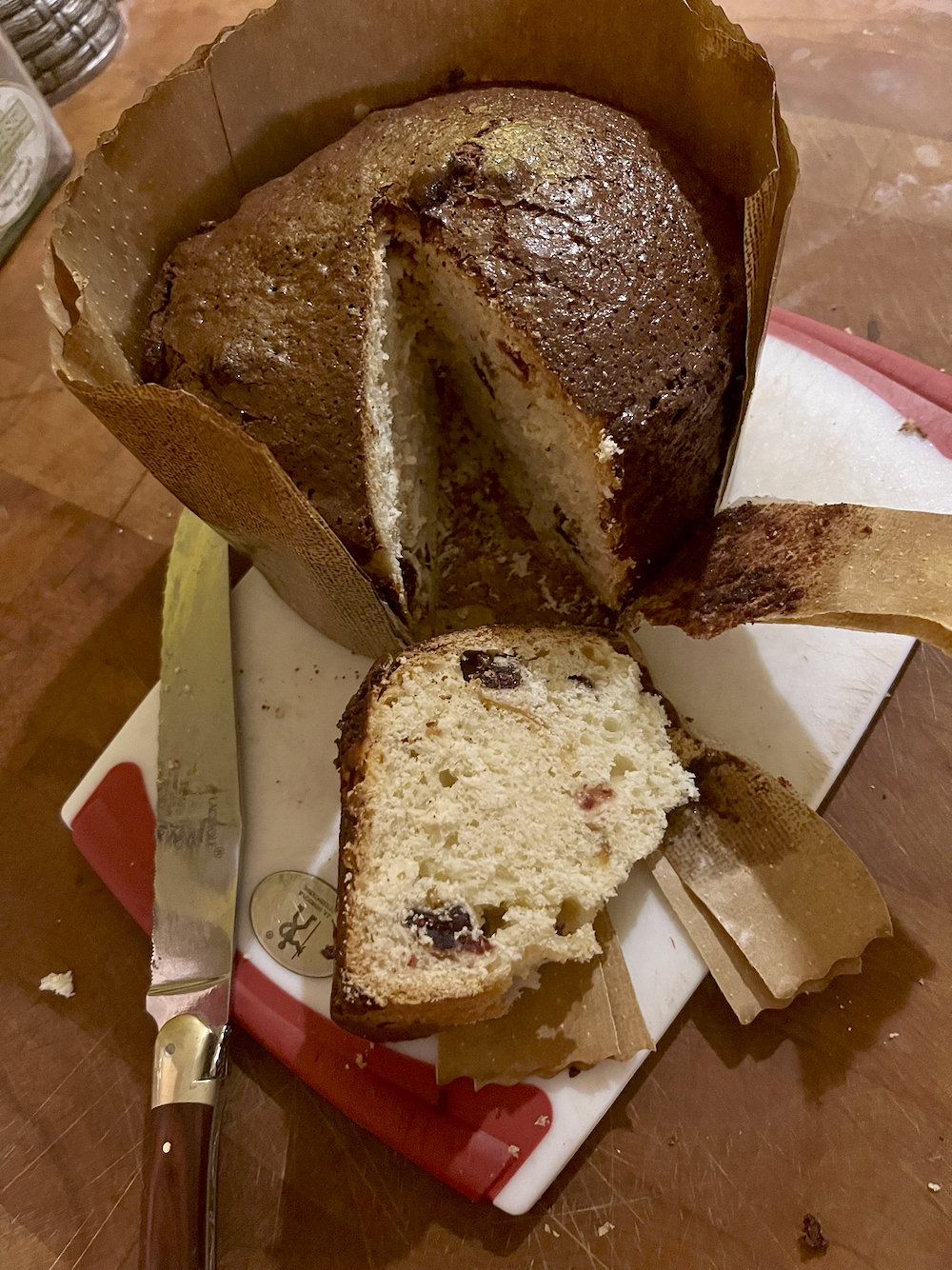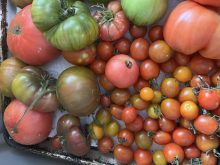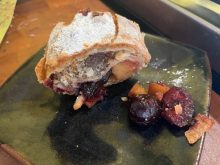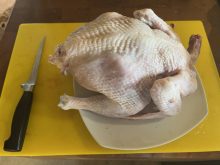Panettone is the Armani of sourdough, a tall, tender, airy dome garnished with raisins and candied citrus, sometimes glazed with chocolate. Complex and subtle, it is immensely popular in Italy and around the world. Making panettone is a patient multi-day process, which may be why so many Italians buy theirs. But it’s worth it, in the same way making a beautiful piece of clothing or a remarkable meal is worth a home artisan’s time and effort.
Years ago, I began a quest to perfect panettone with varying results, all delicious but not quite right. I tried loaf pans, yeast in place of starter, a tube pan, then no pan at all, just free-form loaves on a tray. Last year, I bought paper moulds for my panettone. But I ran into problems at the final and crucial step when I couldn’t come up with a stable spot to invert the baked loaves — the fragile structures collapsed when I left them upright to cool.
This year I used paper moulds, bought 12-inch bamboo skewers and made inversion plans in advance. For 12 hours — after two days of mixing, kneading and waiting on multiple uprisings that finally led to baking — my kitchen counters were crowded with big bowls and pots, panettones suspended by horizontal pairs of bamboo skewers that were inserted through the paper moulds at the base of each loaf. But I had faltered on stretching and kneading in the earlier stages, so the finished texture was akin to brioche, rich and buttery but not classically airy.
Read Also
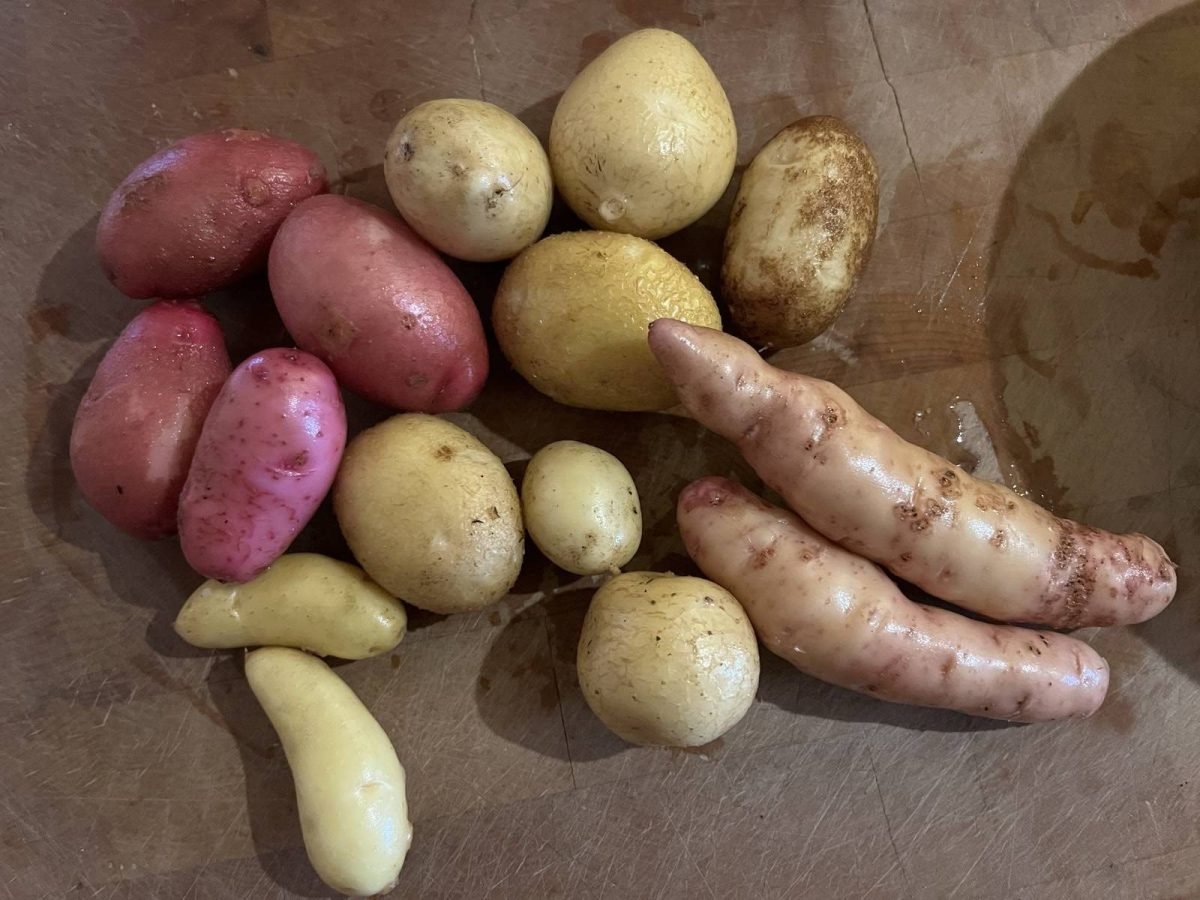
Putting down roots, part 2: Potatoes
Saskatchewan author and chef dee Hobsbawn-Smith offers a retrospective on the potato’s cultural journey from the Americas to Europe and back, and a recipe for butter-basted baby potatoes with rosemary.
All it means is that I’ll have to try again. My friends and family will have to endure eating panettone again. So first we eat, then we’ll analyze the loaf, refresh the starter, and start again.
Panettone
This is an adaptation of chef Andrea Tortora’s fabulous panettone recipe from greatitalianchefs.com.
Because of the multiple risings in making panettone, I use finely textured high protein doppio 00 (double zero) pizza flour as the bread flour. Also, make sure your sourdough starter is active and ready to use — feed it twice daily for two days preceding this project. Do not omit the final step of inversion.
For the best flavour, make the candied citrus yourself. Peel and chop the zest (coloured rind only) of four oranges and place in a small pot. Cover with cold water and bring to a boil. Drain, discard the water and cover with fresh cold water. Bring to a boil, drain and cover with cold water a third time. Add two cups white sugar and simmer until tender, about 45-60 minutes, adding water as the syrup thickens. Remove the peel when it is tender and save the syrup for another purpose.
This recipe makes three six-inch panettones.
First dough:
- 1/4 teaspoon instant yeast
- 2/3 cup warm water
- 2/3 cup sugar
- 1 pound bread flour
- 3 large egg yolks
- 2 cups active sourdough starter
- 1/2 cup unsalted butter, softened
Second dough:
- 2 cups bread flour
- 1/2 cup sugar
- 3 large egg yolks
- 1 tablespoon melted honey
- 1 vanilla bean, seeds scraped out and pod reserved for another use, or 1 teaspoon vanilla bean paste
- 1 orange, zest only
- 1 lemon, zest only
- 1 teaspoon kosher or fine sea salt
- 1/2 cup unsalted butter, softened
- 1 cup chopped citrus peel
- 1/2 cup raisins (a mix of Thompson and golden)
- 1/2 cup chopped pistachios
Glaze:
- 1/3 cup sugar
- 1 teaspoon sunflower oil
- 1 teaspoon corn flour
- 1 tablespoon cocoa powder 1/2 cup almond flour
- 1 large egg white
Combine yeast, water and one teaspoon sugar in a large mixing bowl for a stand mixer. When the yeast blooms (after about five minutes), add remaining sugar, flour and half the egg yolks.
Mix thoroughly to obtain a smooth and elastic dough. Add sourdough starter and remaining egg yolks, mixing until combined. Add butter a little at a time. Mix well. Cover with a cloth and leave to triple in volume for 12 hours at room temperature.
Next morning, add the second dough flour to the first dough. Use a stand mixer to knead for 15 minutes. If the dough is wet, add a little more flour. Add sugar and egg yolks in three additions.
Mix in honey, vanilla seeds or paste, orange and lemon zests. Add salt and mix for three minutes.
Gradually add the butter and mix until smooth. Add the candied citrus, raisins and pistachios. Mix well. Turn dough onto floured countertop and fold over repeatedly on itself until the dough coheres and isn’t sticky.
Turn into a bowl, cover with a cloth, and rest for 30 minutes. Stretch one side of the dough as far as you can and fold it over the top. Work your way around the bowl until all the dough has been stretched and folded. Cover and rest another 30 minutes.
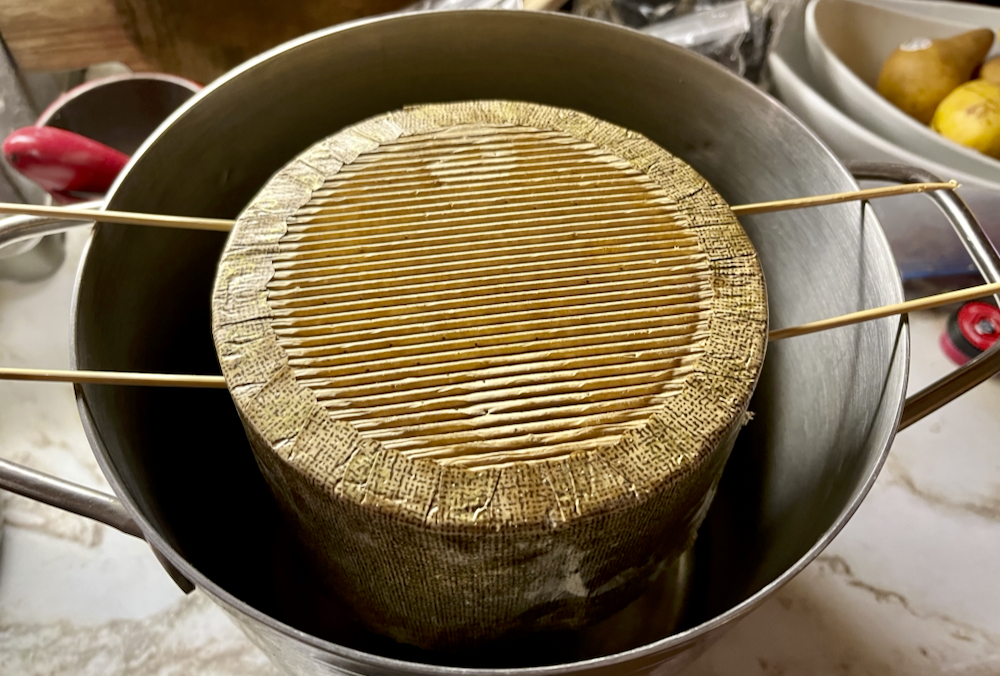
Divide the dough in thirds. Shape each into a ball, gently stretching the dough as tightly as possible to form a taut surface. Place in three six-inch paper panettone moulds. Cover with a cloth and let rise for 4-6 hours at room temperature. If you refrigerate the dough overnight, bring it to room temperature the next morning for an hour before baking.
Preheat oven to 350 F. Mix together glaze ingredients, adding additional egg white if needed to make it spreadable. Divide the glaze among the three loaves and spread over the top. Bake for 35-50 minutes, or until the internal temperature is 185 F.
Remove from the oven. Insert two 12-inch bamboo skewers parallel to each other just above the bottom of the bread. Hang each round upside down by suspending them by the protruding skewers inside a large pot or bowl for 12 hours. Slice into wedges to serve.

